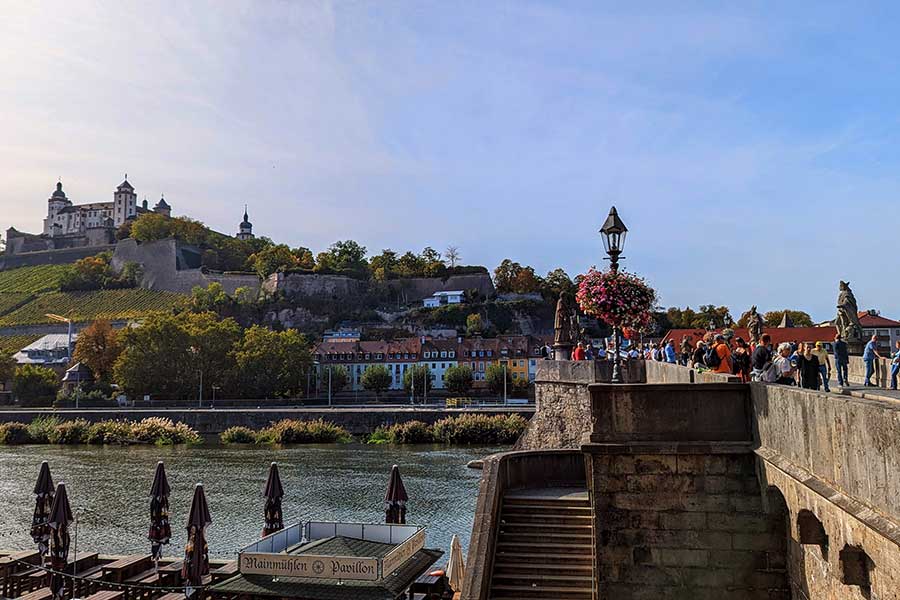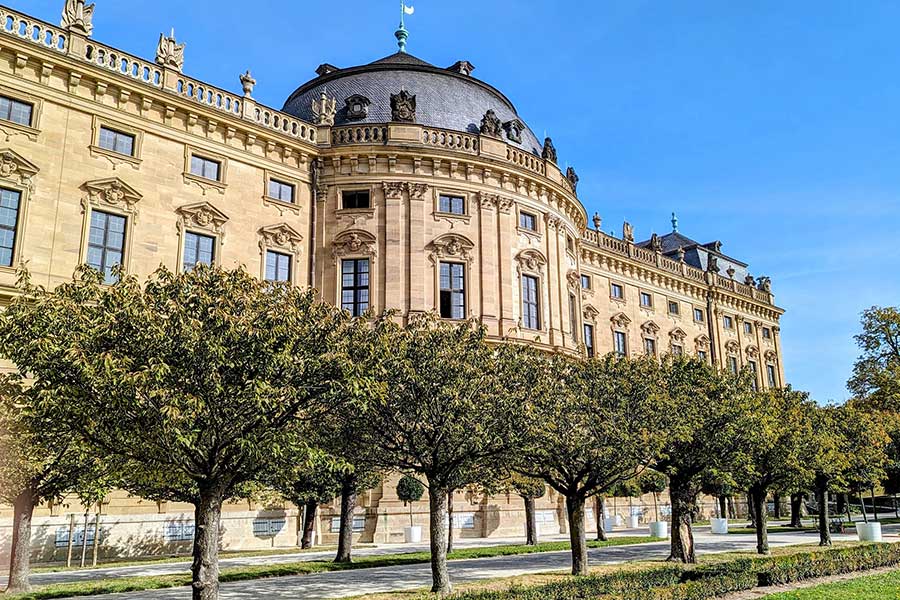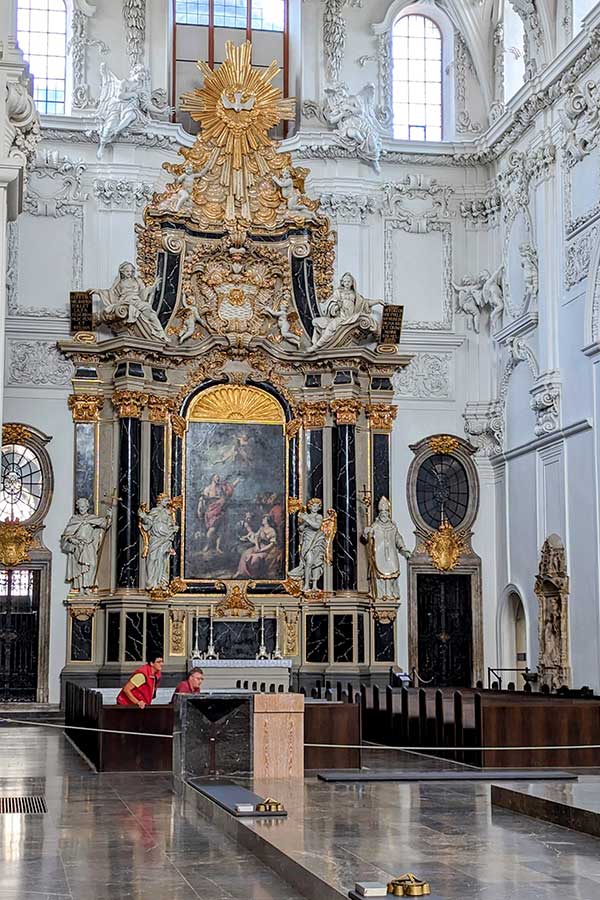With a day trip to Würzburg, Germany, you can soak up the culture and history of this remarkable city before enjoying one of the locals’ favorite pastimes: sipping wine on the incredibly picturesque Old Main Bridge that crosses the Main River, connecting the Altstadt and the fortress. The vineyards are a surprise in beer-rich Bavaria but the northern Franconian region has put its stamp on wine. The city is spectacularly beautiful and walkable: from the fortress sitting high upon the hills growing grapes for wine to its Versailles-inspired palace.
A Brief History of Würzburg
Würzburg lies in the Franconia region of northern Bavaria, near the borders with the German states of Hessen and Baden-Württemberg. It sits roughly midway between Frankfurt and Nuremberg. The Main River cuts the city in two with the hulking Marienberg Fortress on the western side and the scenic old city, or Altstadt, on the eastern.
Today, it is a popular university town with many students calling it home. But the region’s roots go back, way back. Both the Celts and Romans had military fortifications on the site where Marienberg Fortress now stands. Irish missionaries, Saints Kilian, Kolonat, and Totnan, brought Christianity to the town in the late 7th century and ended up paying for it with their lives. The trio were executed, as the story goes, for opposing the marriage of the town’s ruler to his brother’s widow.
But Christianity spread and so too did the Holy Roman Empire. The city was home to one of the empire’s Imperial Diets.
Fast forward to World War II, when 90% of the city was destroyed in bombings by British bombers. Less than two months later, Germany formally surrendered.
Würzburg Wine
The first thing you think of when you think of Bavaria is probably beer and beer festivals like Oktoberfest. But Würzburg is wine country. For the last 1200 years, grapes have been grown for wine on the limestone hills along the Main River in the oldest winemaking region in the country. Silvaner and Riesling are the most common varieties grown here. The bottle of the Silvaner white wines are instantly recognizable for their flat, round bottles which have protected status in the European Union.
Visitors who enjoy wine and wine culture will want to dive in head first by visiting local vineyards, taking tours, and doing tastings.
Things to Do in Würzburg
Old Main Bridge (Alte Mainbrücke)
The Old Main Bridge, or Alte Mainbrücke, is an impressive bridge that spans the Main River, connecting the city. The bridge replaced an earlier Romanesque bridge and construction was completed in the mid-16th century. The dozen statues of saints that line the bridge were added roughly two hundred years later.
Today the bridge is a pedestrian-only zone, making it extremely popular with locals, students, and tourists. Foot traffic flows right out of the Altstadt on the east and across the bridge towards the Marienberg Fortress on the western bank.
On the eastern side, on the bank’s edge sits Gasthaus Alte Mainmühle. The restaurant offers table service overlooking the river with stunning views. Or, you can embrace local life and purchase a drink or a bite to eat from the window on the bridge. Grabbing a glass of Silvaner from Alte Mainmühle and enjoying it on the Alte Mainbrücke is a popular pastime and an absolute must-do for anyone visiting the city. Just don’t place your glass on the bridge itself! The city has roaming security that will kindly request you move your glass, for safety reasons.
Marienberg Fortress (Festung Marienberg)
Over the centuries, there were different buildings on the site of what we today recognize as the Marienberg Fortress. It’s not an uncommon story in history. But the fortress that we know, which served as the residence of the Prince-Bishops, dates to about the 13th century. They ruled from there until 1720 when they moved to the Würzburg Residence.
But during the roughly 500 years of use, the fortress saw its fair share of conflicts. It withstood a siege of peasants in 1525 during the German Peasants’ War and it was stormed by the Swedes in 1631 during the Thirty Years’ War.
Today, visitors can tour certain portions of the fortress. It is also home to the Museum für Franken, which celebrates Franconian culture and heritage. It includes the largest collection of works by Tilman Riemenschneider, the master woodcarver and sculptor.
Würzburg Residence (Würzburger Residenz)
While it may be a university town, there is nothing modest or humble about the Würzburg Residence (Würzburger Residenz). The UNESCO World Cultural Heritage Site started construction in 1720 after Johann Philipp Franz von Schönborn, the Prince-Bishop of Würzburg, felt the palace he was living in simply wasn’t grand enough.
He brought his uncle, the Archbishop of Mainz and Elector of Mainz, and his brother, the Imperial Vice-Chancellor in Vienna, in on a project to build something newer and better. The three tasked Johann Lukas von Hildebrandt with the job. Hildebrandt had made a name for himself with his ambitious and opulent buildings in Vienna, like Belvedere Palace and St. Peter’s Church.
But less than a decade after work began, Schönborn’s successor ordered a stop to the construction. Only the northern block was completed. Construction resumed in 1730, when Johann’s brother, Friedrich Karl von Schönborn, became the Prince-Bishop in charge.
Architect Balthasar Neumann is widely credited with the palace’s grandiose look. He created its massive Main Staircase with a vaulted ceiling so large that many wondered if it was even possible. The ceiling fresco by master painter Giovanni Battista Tiepolo is considered the largest in the world.
What you may notice when visiting the Main Staircase and many of the rooms within the Würzburger Residenz are the subtle details in the artwork. Unusually, the frescoes are three-dimensional. In the corners of the ceiling, legs dangle down and weapons protrude from the flat painted surface.
One room after the next at the Würzburger Residenz impresses. And so does the lavish garden just outside its windows. Beautifully manicured hedges create walkways and places to steal away for a quiet moment while beds overflowing with roses beckon and fountains artfully arch streams of water.
Würzburg Churches
The city has some remarkable churches that are worth visiting.
The Würzburger Dom (Würzburg Cathedral), is also known as St. Kilian’s Cathedral and is the fourth largest Romanesque church in the country. The current church was built in the 11th century after prior churches on the site were destroyed by fires. The church houses relics from Saints Kilian, Kolonat, and Totnan, the Irish missionaries who were killed in the city. The cathedral is also the final resting place of countless Prince-Bishops, including several of the Schönborn family.
Nearby, is the Neumünster Cathedral from the 11th century. Built on the site of the graves of the Irish missionaries, the church features an ornate Baroque exterior that dates to the early 1700s.
The Marienkapelle (Maria Chapel) sits on the edge of the city’s market square. The Gothic-style church dates to the 14th century. The site was previously the home to a synagogue. But during a pogrom in 1349, the holy temple was destroyed and several decades later construction on a church began.
Notably, the churches feature works of art by Riemenschneider.
Würzburg Restaurants
Pedestrian-friendly cities are only ideal if there are good restaurants to relax and refuel at. And here that isn’t a problem. Wirtshaus am Dom is centrally located next to the city’s cathedral and offers all of the traditional Franken touches you’re looking for while still feeling fresh and modern.
Getting There and Getting Around
A Würzburg day trip is easy to accomplish because of its location between major hubs like Frankfurt and Nuremberg. Budget-friendly transit options include buses like FlixBus or, if you’re using the Deutschland Ticket, regional trains. For a little bit more, there’s the high-speed ICE trains. With the ICE train, you can enjoy a day trip from Munich to Würzburg in approximately two hours without any transfers.
Once you get to the city, the Altstadt is fairly compact making it very pedestrian-friendly. It is, however, a bit of a walk to the Marienberg Fortress not least because of its hill-top location. However, once you are up there, there is plenty more to explore including several gardens and a panoramic walking path that offers stunning views over the valley, including the grapes trellised on the hillside.
But for those who want to get a lay of the land, visitors can enjoy sightseeing without walking a step with tours on the Bimmelbahn Train.
Tips for a Würzburg Day Trip
If you are traveling around Bavaria and are planning to visit the Würzburg Residenz and/or the Marienberg Fortress, it is worth considering the Bavarian Palace Department’s 14-day ticket to save money while traveling in Bavaria.
Save this post on Pinterest!
All photos, as well as opinions, are my own. This post contains affiliate links.











